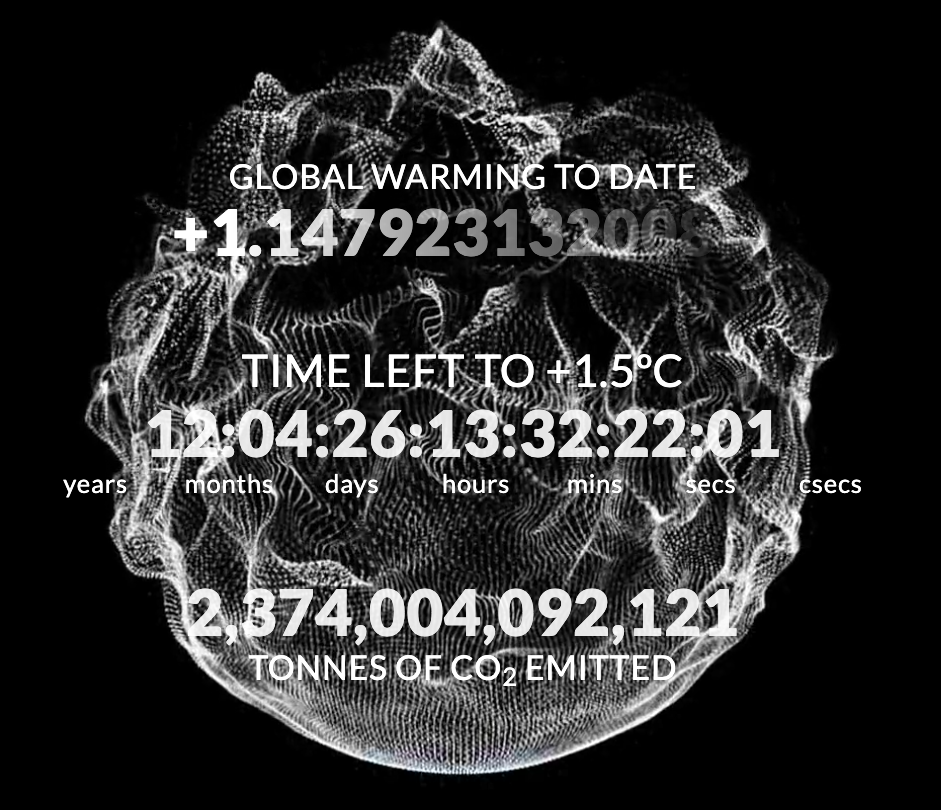Study Guide: Climate Clock
About
In signing the Paris Agreement, the world has committed to limiting the global average temperature increase to between 1.5 and well-below 2°C above pre-industrial averages, so as to avoid the most dangerous consequences of global warming. But how far away is this threshold? And what do we need to do to change direction? The Climate Clock acts as a public line in the sand and says, this is the date. It is a measuring stick by which we can evaluate our progress.
The Climate Clock is based on the best available science and is updated each year to reflect the latest data by a team of leading climate scientists from around the world. Each year, we are able to show how close we are to the lower limit of the Paris temperature goal, and can measure whether we gained or lost time over the past year.
Humanity has the power to add time to the Clock, but only if we work collectively and measure our progress against defined targets.
The Numbers of the clock
The Climate Clock answers the question: given the current trend of global CO2 emissions and the level of human-induced warming, how long will it be until we emit enough to cause global temperatures to reach 1.5°C?
1) Tonnes of CO2 Emitted
CO2 emitted by human activities such as fossil fuel burning and deforestation is the primary driver of global warming. Furthermore, the total amount of CO2 emitted over time is a strong predictor of the global average temperature increase. Here, we show the total accumulated CO2 emissions from fossil fuel burning, cement manufacture, and land-use change since 1870, based on the most recent data from the Global Carbon Project.
2) Global Warming to Date
The latest IPCC report has concluded that human influence on the climate system is now unequivocal, and that we are responsible for virtually all of the observed global temperature increase. Here, we show humanity’s total influence on global warming over the past 150 years. This Global Warming Index represents the portion of observed temperature change that can be attributed to all human drivers of climate change. We use 1850-1900 as the reference temperature for the “pre-industrial” period. This is the earliest period for which we have reliable measurements of global temperature, and is the most common reference period for pre-industrial temperatures used in scientific analyses and policy discussions.
3) Time left to 1.5
The time remaining until we reach +1.5°C above pre-industrial temperature is estimated based on projecting forward the current trend in global CO2 emissions and calculating the time until we emit the remaining carbon budget – i.e. the total allowable future emissions required to limit warming to 1.5°C. Fossil fuel emissions increased by about 1% (or 0.3 billion tonnes) per year between 2016 and 2019 and then decreased by more than 5% in 2020 as a result of COVID-19 lockdowns around the world. In 2021, emissions rebounded to near-2019 levels, resulting in an upward 5-year trend of about 0.5% per year. We assume fossil fuel CO2 emissions follow this trend, while additional CO2 emissions from deforestation remain constant at the average level of the past 5 years. We use the best estimate of the remaining carbon budget from the IPCC Sixth Assessment Report, which for the 1.5°C temperature target corresponds to 500 billion tonnes from 2020 onwards.


